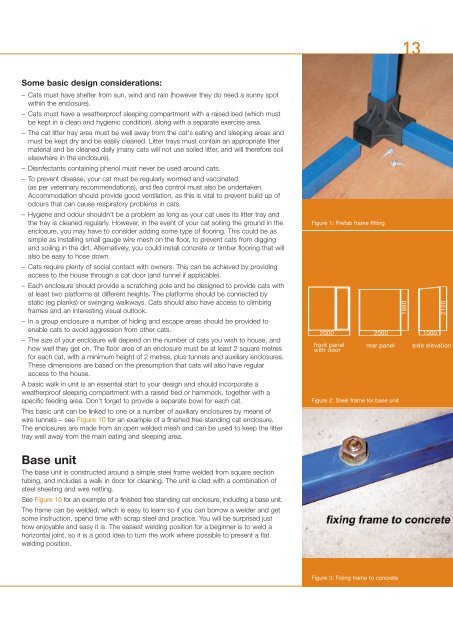How to build a cat enclosure - City of Tea Tree Gully
How to build a cat enclosure - City of Tea Tree Gully
How to build a cat enclosure - City of Tea Tree Gully
You also want an ePaper? Increase the reach of your titles
YUMPU automatically turns print PDFs into web optimized ePapers that Google loves.
13Some basic design considerations:– Cats must have shelter from sun, wind and rain (however they do need a sunny spotwithin the <strong>enclosure</strong>).– Cats must have a weatherpro<strong>of</strong> sleeping compartment with a raised bed (which mustbe kept in a clean and hygienic condition), along with a separate exercise area.– The <strong>cat</strong> litter tray area must be well away from the <strong>cat</strong>'s eating and sleeping areas andmust be kept dry and be easily cleaned. Litter trays must contain an appropriate littermaterial and be cleaned daily (many <strong>cat</strong>s will not use soiled litter, and will therefore soilelsewhere in the <strong>enclosure</strong>).– Disinfectants containing phenol must never be used around <strong>cat</strong>s.– To prevent disease, your <strong>cat</strong> must be regularly wormed and vaccinated(as per veterinary recommendations), and flea control must also be undertaken.Accommodation should provide good ventilation, as this is vital <strong>to</strong> prevent <strong>build</strong> up <strong>of</strong>odours that can cause respira<strong>to</strong>ry problems in <strong>cat</strong>s.– Hygiene and odour shouldn’t be a problem as long as your <strong>cat</strong> uses its litter tray andthe tray is cleaned regularly. <strong>How</strong>ever, in the event <strong>of</strong> your <strong>cat</strong> soiling the ground in the<strong>enclosure</strong>, you may have <strong>to</strong> consider adding some type <strong>of</strong> flooring. This could be assimple as installing small gauge wire mesh on the floor, <strong>to</strong> prevent <strong>cat</strong>s from diggingand soiling in the dirt. Alternatively, you could install concrete or timber flooring that willalso be easy <strong>to</strong> hose down.– Cats require plenty <strong>of</strong> social contact with owners. This can be achieved by providingaccess <strong>to</strong> the house through a <strong>cat</strong> door (and tunnel if applicable).– Each <strong>enclosure</strong> should provide a scratching pole and be designed <strong>to</strong> provide <strong>cat</strong>s withat least two platforms at different heights. The platforms should be connected bystatic (eg planks) or swinging walkways. Cats should also have access <strong>to</strong> climbingframes and an interesting visual outlook.– In a group <strong>enclosure</strong> a number <strong>of</strong> hiding and escape areas should be provided <strong>to</strong>enable <strong>cat</strong>s <strong>to</strong> avoid aggression from other <strong>cat</strong>s.– The size <strong>of</strong> your <strong>enclosure</strong> will depend on the number <strong>of</strong> <strong>cat</strong>s you wish <strong>to</strong> house, andhow well they get on. The floor area <strong>of</strong> an <strong>enclosure</strong> must be at least 2 square metresfor each <strong>cat</strong>, with a minimum height <strong>of</strong> 2 metres, plus tunnels and auxiliary <strong>enclosure</strong>s.These dimensions are based on the presumption that <strong>cat</strong>s will also have regularaccess <strong>to</strong> the house.A basic walk in unit is an essential start <strong>to</strong> your design and should incorporate aweatherpro<strong>of</strong> sleeping compartment with a raised bed or hammock, <strong>to</strong>gether with aspecific feeding area. Don’t forget <strong>to</strong> provide a separate bowl for each <strong>cat</strong>.This basic unit can be linked <strong>to</strong> one or a number <strong>of</strong> auxiliary <strong>enclosure</strong>s by means <strong>of</strong>wire tunnels – see Figure 10 for an example <strong>of</strong> a finished free standing <strong>cat</strong> <strong>enclosure</strong>.The <strong>enclosure</strong>s are made from an open welded mesh and can be used <strong>to</strong> keep the littertray well away from the main eating and sleeping area.Figure 1: Prefab frame fitting2000 2000 1000front panelwith doorrear panelFigure 2: Steel frame for base unit19802120side elevationBase unitThe base unit is constructed around a simple steel frame welded from square sectiontubing, and includes a walk in door for cleaning. The unit is clad with a combination <strong>of</strong>steel sheeting and wire netting.See Figure 10 for an example <strong>of</strong> a finished free standing <strong>cat</strong> <strong>enclosure</strong>, including a base unit.The frame can be welded, which is easy <strong>to</strong> learn so if you can borrow a welder and getsome instruction, spend time with scrap steel and practice. You will be surprised justhow enjoyable and easy it is. The easiest welding position for a beginner is <strong>to</strong> weld ahorizontal joint, so it is a good idea <strong>to</strong> turn the work where possible <strong>to</strong> present a flatwelding position.Figure 3: Fixing frame <strong>to</strong> concrete

















